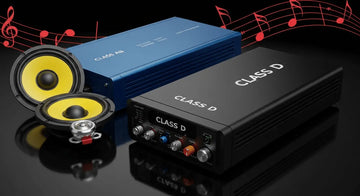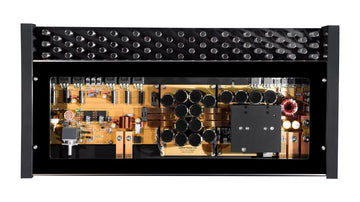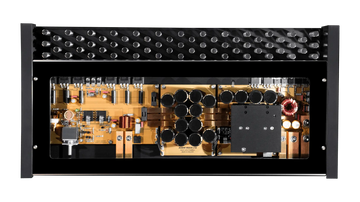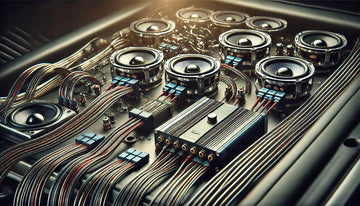Class AB Amplifiers
Related Collections
Featured Products
US Acoustics Lisa | 4 Channel Class AB Amplifier | 4 x 50w
US Acoustics Wendy | 2 Channel Class AB Amplifier | 2 x 75w
Ground Zero GZIA 2.135 2-Channel High Quality Class A/B Amplifier
Ground Zero GZIA 4.120 4-Channel High Quality Class A/B Amplifier
US Acoustics Andrea | 2 Channel Class AB Amplifier | 2 x 150w
Rainbow Audio DL-A4100 4 Channel Class AB Amplifier
Ground Zero GZIA 1.700 1-Channel High Quality Class AB Amplifier
Xcelsus - MAGMA 220.4AB 4 channel amplifier Class AB - Previous Demo
US Acoustics Barbara Ann | 4 Channel Class AB Amplifier | 4 x 100w
Crescendo REVOLUTION 3A4 4 channel Amplifier
Rainbow Audio SL-A4150 4 channel Class AB Amplifier
US Acoustics Lanna | 6 Channel Class AB Amplifier | 6 x 150w
Crescendo REVOLUTION 5A1 1 Channel Amplifier
Crescendo REVOLUTION 5A4 4 channel Amplifier
Xcelsus - MAGMA 220.4AB 4 channel amplifier Class AB
Crescendo REVOLUTION 7A4 4 Channel Amplifier
Tru Technologies Tungsten Grande Class AB 4 Channel Amplifier
Audio Wave Excel | 2 Channel Class AB Amplifier
Audio Wave Excel Monoblock | Full Range Class AB 1 channel Amplifier
Audio Wave Excel TST | 6 Channel Class AB Amplifier | Previous Display
Audio Wave Aspire Pro USA
Audio Wave Aspire Pro USA (Display Model)
Audio Wave Aspire Pro 6 Channel Amplifier | Previous Demo
All products loaded
Unleashing Power and Purity: Your Guide to Class AB Car Amplifiers

Welcome to the sweet spot of car audio. If you're chasing the perfect balance between warm, detailed sound and real-world efficiency, you've likely heard of the legendary class ab car amplifier. For decades, this design has been the go-to choice for enthusiasts who refuse to compromise on sound quality. It’s a masterful blend of power, precision, and practicality that even newer, more compact technologies struggle to match.
Unlike other amplifier classes that prioritize one feature over another, Class AB is the seasoned veteran that does it all with grace. It's the secret behind countless award-winning car audio systems. This guide will demystify the technology, highlight its advantages, and give you the knowledge to choose the perfect Class AB amplifier to turn your daily drive into a private concert.
What Exactly is a Class AB Car Amplifier?
At its heart, an amplifier's job is simple: take a small audio signal from your head unit and make it powerful enough to move your speakers. The "class" of an amplifier describes how it does this, specifically how its internal transistors handle the audio signal. To understand Class AB, we first need to look at its predecessors: Class A and Class B.
-
Class A: This is the purist's choice. In a Class A amp, the output transistors are always on, constantly conducting electricity. This means they are instantly ready to reproduce the entire audio waveform without any delay. The result is incredibly pure, linear, and distortion-free sound. The massive downside? Extreme inefficiency. Most of the power they draw becomes heat, not sound, making them large, hot, and impractical for most cars.
-
Class B: This is the efficiency expert. A Class B amp uses a "push-pull" design where one transistor handles the positive half of the sound wave and another handles the negative half. Each transistor is only on for its half of the job. This is far more efficient than Class A, but it creates a problem: a tiny delay as the signal "crosses over" from the positive to the negative transistor. This results in "crossover distortion," which can sound harsh and unmusical, especially during delicate high-frequency passages.
The car amplifier class ab design is the genius compromise. It uses the "push-pull" setup of Class B but gives the transistors a small amount of power at all times, even when idle. This "bias current" is just enough to keep them on the verge of conducting, which eliminates the crossover delay. When a signal comes through, the transition is seamless. This design lets a class ab amplifier for car audio deliver sound quality that rivals Class A, but with efficiency much closer to Class B. The result is a near-perfect balance: the warm, detailed sound audiophiles crave, plus an efficiency of around 50-60% that works beautifully within a car's electrical system.
Why Choose a Class AB Car Amplifier for Your Audio System?
In a market flooded with ultra-compact Class D amplifiers, why does the class ab car audio amplifier remain a top contender for serious listeners? The answer comes down to a unique set of benefits that create a more immersive and enjoyable listening experience on the road. When you're building a system where sound quality is the top priority, the advantages of a Class AB amplifier are hard to ignore.
-
Superior Sound Quality: This is the number one reason. A Class AB amp’s design minimizes the switching distortion that can give some Class D designs a subtle harshness or "digital" character. Class AB amps are celebrated for their warm, natural, and dynamic sound. They reproduce vocals with lifelike presence, cymbals with a smooth decay, and instruments with rich tonal accuracy. For many audiophiles, this rich "musicality" is a non-negotiable part of high-fidelity audio.
-
Balanced Efficiency and Heat: While a Class A amp might sound divine, it would turn your trunk into an oven and put a huge strain on your alternator. A class ab amplifier car audio setup, on the other hand, operates with reasonable efficiency. It generates more heat than a Class D amp, so it needs a larger heatsink and good ventilation, but it's a manageable trade-off for the sonic benefits. This balance makes it a powerful yet practical solution for most car stereo upgrades.
-
Proven Versatility: Class AB amplifiers are the Swiss Army knives of the car audio world. Their robust design and linear output make them exceptionally good at driving a wide variety of speakers. They provide the clean, detailed power needed for delicate tweeters and midrange drivers, but also have the muscle to control midbass speakers and smaller subwoofers with authority. A single 4-channel Class AB amp can often run an entire system with stunning results.
-
Refined and Reliable Technology: Class AB isn't new or unproven. It has been the backbone of high-quality home and car audio for decades, so the designs have been continuously refined. You're investing in a mature, stable, and reliable technology that manufacturers have perfected, resulting in products known for exceptional build quality and longevity.
Key Features to Consider When Buying a Class AB Car Amp
Choosing the right class ab car amp involves more than just picking the biggest or shiniest box. Understanding a few key specs will ensure you get an amplifier that not only works with your system but makes it truly sing. Let's break down the technical jargon into practical buying advice.
-
RMS Power Output: Ignore "Peak" or "Max" power ratings; they're mostly marketing fluff. The number you care about is RMS (Root Mean Square) power. This is the continuous, real-world power the amplifier can deliver. Match the amp's RMS output to the RMS power handling of your speakers for a safe, optimal pairing.
-
Number of Channels: This determines how many speakers you can power.
-
2-Channel: Ideal for a pair of speakers or for bridging to power a single subwoofer.
-
4-Channel: The most versatile option, perfect for front and rear speakers, or for powering front speakers and a bridged subwoofer.
-
5-Channel: An all-in-one solution, typically with four channels for your main speakers and a fifth, more powerful channel for a subwoofer.
-
-
Impedance Stability: Impedance (measured in ohms, Ω) is your speakers' electrical resistance. Most car speakers are 4 ohms. An amplifier that is "2-ohm stable" can safely power speakers with a lower impedance, delivering more power in the process. This is a sign of a robust internal power supply.
-
Signal-to-Noise Ratio (SNR): Measured in decibels (dB), this tells you how much louder the audio is compared to the background hiss from the amp's own circuitry. A higher SNR is better—look for ratings of 90dB or more for clean, quiet operation.
-
Total Harmonic Distortion (THD): This measures how much the amplifier alters the original audio signal. A lower percentage is better, indicating cleaner, more accurate sound. For a quality Class AB amp, a THD rating below 0.05% is excellent.
-
Built-in Crossovers: These are essential tools. A High-Pass Filter (HPF) blocks low bass from reaching smaller speakers that can't handle it. A Low-Pass Filter (LPF) does the opposite, sending only bass frequencies to a subwoofer. Adjustable crossovers give you precise control over your sound.
-
Protection Circuitry: A good amplifier protects itself. Look for built-in circuits that guard against overheating (thermal), shorted speaker wires (short circuit), and unsafe voltage levels. These features are crucial for the long-term health of your investment.
Installation & Setup Tips for Your Class AB Amplifier
Proper installation is just as important as the amplifier's quality. A poorly installed amp will perform poorly and can even be dangerous. Since a car amplifier class a b design generates more heat than its Class D counterpart, paying attention to wiring and ventilation is critical for performance and safety.
-
Proper Wiring is Non-Negotiable: Use an appropriately sized amplifier wiring kit. The power and ground wires must be thick enough (lower gauge number) to handle the current the amp demands. Undersized wire can starve the amp for power, limit its output, and create a fire hazard. Always use a high-quality, dedicated ground point with a short wire.
-
Fuse for Safety: Always install an inline fuse on the main power wire, as close to the car's battery as possible (typically within 18 inches). This fuse doesn't protect the amplifier; it protects your car from catching fire if there's a short circuit.
-
Quality RCA Interconnects: RCA cables carry the delicate audio signal from your head unit to the amp. Cheap, poorly shielded cables are a primary cause of engine noise (alternator whine) and other interference. Invest in quality twisted-pair or double-shielded RCAs.
-
Remote Turn-On Wire: This small wire tells your amplifier when to turn on and off with your head unit. Connect it securely from the head unit's remote output to the amplifier's remote terminal to prevent draining your battery.
-
Gain Matching (Not a Volume Knob!): The "gain" or "input sensitivity" control matches the amplifier's input level to the head unit's output voltage. It is not a volume control. Setting it too high will introduce distortion (clipping) and can damage your speakers. Set it carefully with test tones or by ear, turning it up until you just begin to hear distortion, then backing it off slightly.
-
Choose a Smart Mounting Location: Class AB amplifiers need to breathe. Mount your amp where it has adequate airflow around its heatsink, like on the back of a rear seat or an amp rack in the trunk. Avoid burying it under carpets or in tight, unventilated enclosures.
If you're not comfortable working with your car's electrical system, we strongly recommend professional installation. An expert can ensure your system is safe, reliable, and sounds its absolute best.
Maximizing Performance: Pairing Your Class AB Amplifier for Optimal Sound
An incredible amplifier is only one piece of the puzzle. To achieve truly breathtaking sound, your class ab car amplifier must work in harmony with your other audio components. System synergy is key, and careful matching will unlock the full potential of your investment.
-
Speaker Compatibility: The golden rule is to match the amplifier's RMS power output to your speakers' RMS power handling. Ideally, you want an amp that provides slightly more power than the speakers are rated for (e.g., a 100W RMS amp for 75W RMS speakers). This gives you "headroom," allowing the amp to cleanly reproduce dynamic musical peaks without straining or clipping.
-
Subwoofer Integration: If you're using a Class AB amp for a subwoofer, ensure it's up to the task. This could mean bridging two channels of a stereo amp to create a single, more powerful mono channel, or using a dedicated 5-channel amp. Match the subwoofer's impedance (e.g., 2-ohm or 4-ohm) to what the amplifier can safely handle to extract the best performance.
-
The Source Unit Matters: Your head unit is the brain of your system. A high-quality amplifier can only amplify the signal it's given. If the signal from your head unit is noisy or distorted, the amplifier will simply make that noise and distortion louder. A good aftermarket head unit with clean, high-voltage pre-amp outputs (4V or higher) provides a much better foundation for your amp to build upon.
-
Don't Forget Sound Deadening: A car is a terrible acoustic environment, full of vibrations, rattles, and road noise. Applying sound deadening material to your doors, floor, and trunk reduces these unwanted noises. This lowers the noise floor, allowing the subtle details and dynamics from your Class AB amp to shine through, dramatically improving clarity and mid-bass impact.
-
Consider Professional Tuning: To take your system to the next level, consider having it professionally tuned. An expert with tools like a Real-Time Analyzer (RTA) and a Digital Signal Processor (DSP) can precisely adjust equalization, time alignment, and crossover points to perfectly tailor the sound to your car's acoustics and your personal listening preferences.
Find Your Perfect Class AB Car Amplifier Today
You now have the knowledge to navigate the world of the class ab car amplifier with confidence. You understand that it represents a time-tested commitment to audio excellence, offering a listening experience that is rich, detailed, and emotionally engaging. It's the choice for the driver who hears the difference—who values the warmth of a vocalist's breath or the natural decay of a cymbal over sheer volume or compact size.
By balancing superior sound with practical efficiency, the Class AB amplifier remains a top choice for discerning car audio enthusiasts. It’s the heart of a system built for pure musical enjoyment. Armed with your understanding of power ratings, channels, and essential features, you're ready to make an informed decision.
Take the next step in your car audio journey. Explore our curated selection of high-performance Class AB amplifiers below. Find the perfect model that matches your speakers, your system goals, and your passion for incredible sound. Your ultimate mobile listening experience is just an upgrade away.
Class AB Amplifiers
Frequently Asked Questions
What is a class AB amp good for?
What is a Class AB amplifier?
What are the disadvantages of Class AB amps?
Do class AB amps run hot?
How efficient is a class AB amplifier?
Related Articles

Class AB vs Class D Amplifiers: Which One Should You Choose?

The Best Class A Amplifier: Key Features and Benefits Explained

Class A Car Amplifiers: The Gold Standard in Sound Quality


























